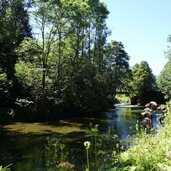There are plenty of destinations in the environs of Vils, among them the Civic Museum, and Neuschwanstein Castle across the border
Image gallery: Vils
Altitude: 826 m a.s.l.
Vils is one of the smallest towns of Austria. It is located at the border to Bavaria and is run through by the Vils river, emptying into the Lech river. Already in 1327 AD, Louis IV, Holy Roman Emperor, vested the municipality with town privileges, then up to the 20th century agriculture was the main economic factor. Today, limestone and marl are mined in the lime stone pit near the municipality, and beautiful buildings with gabled roofs and façade paintings await you in the town centre.
The royal castles of Neuschwanstein and Hohenschwangau are located across the Austrian-German border - the neary Füssen can be reached in a 3.5-hour round tour. The hike leads past mythical Lake Alatsee. One of the legends tells about hoards of gold dumped by the Reichsbank in the lake after WWII, which up to this point of time were stored in Neuschwanstein Castle. Above the village itself rises the Vilsegg Castle ruin, located at the border of Mt. Salober, where the state border runs. Below there is the St. Anna Chapel dating back to the 13th century, the castle chapel.
Among the outdoor offers there are also horse-riding and the Vilser Platte climbing garden: It offers steep ledge climbing on 16 routes. In winter, the surroundings offer pleasant winter hiking trails and cross-country ski trails taking you from Füssen to Reutte across fairytale-like landscape. If you prefer more comfortable activities, you might enjoy a horse-drawn sleigh ride.



















































